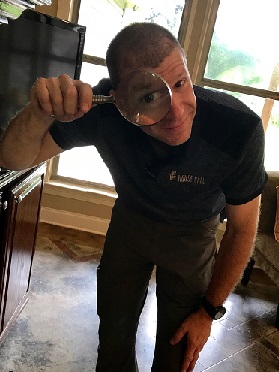Note: This post is the second of a two-part article. Click here to read part one.
There are many things to consider when running a professional home inspection business. Often, the number of things that must be taken into account can be overwhelming, especially for inspectors that are new to the business. As we’re all operating on a limited time schedule, it can be hard to figure out what parts of our business to prioritize. In my opinion, there is only part of my business that takes precedence over everything else: my inspection report.

Obviously, there will be many inspectors who will disagree, as a compelling argument can be made for the importance of any one of the different facets of running a successful small business. Effectively marketing your business is a constant stressor. Scheduling and customer service must be monitored on a continual basis. The administration process (bookkeeping, accounting, recordkeeping, etc.) seems like it never ends. The variety of tasks performed by the small business owner grows longer every day. But, producing a top-quality inspection report seems to top them all.
Without a good report, none of the other stuff you’re doing is going to matter for long. A poor-quality report can undermine every other facet of your business. Roll out a sub-par report for too long, and eventually your client base withers away to nothing. And without clients, there’s no reason to worry about scheduling, marketing or bookkeeping.
It’s clear that there are many different things to consider when attempting to produce a quality inspection report. Making your report accessible to a broad range of clients is, arguably the most important one. Our clients’ construction experience runs the gamut, from professional contractor to inexperienced first-time home buyer. So, our report must be written in a way that makes it easy for every one of our clients (and their agents) to be able to comprehend the information we’re trying to relay.
There are many ways to accomplish this, from phrasing and information to report style and layout. However, in my experience, there’s no better way to do this than with pictures.
Pictures serve so many different purposes in your report, it’s hard to imagine a time when reports were produced without them. A picture can be used to point out a problem or identify an important item that clients should be aware of, like the main electric disconnect. A picture can be used to show exactly where a defect is located, such as which of a room’s seven outlets is miswired. It can be used to demonstrate a deficiency that cannot easily be seen, such as a hole at the peak of a roof. Pictures can also be used to document the conditions that existed at the time of then inspection, such as a garage piled so high with stored goods that the walls cannot even be seen.
Over the years of performing inspections, it’s been my experience that most of my clients aren’t even going to read their inspection reports. It seems counter-intuitive that someone would pay several hundred dollars for a report that they don’t even read, but that’s the reality of our business. But whether they take the time to read their report or not, I can always count on them to look at the pictures. And I can effectively tell the story I need to tell with the pictures that I put in their report.

Among today’s professional home inspectors, there’s a consensus regarding the importance of having pictures in your report. There’s much less agreement as to how many pictures should be included in those reports. Personally, I have a hard time answering the question “How many pictures do you put in the average report,” as it’s not too often that I run across an “average house.”
There are some inspectors who use a minimal number of pictures, documenting only the most egregious deficiencies. Some inspectors let the pictures do the talking for them and use numerous pictures with very little narrative. I imagine that most professionals fall somewhere between these two extremes, including a good number of photographs while using their narrative to properly relay all necessary information to their clients.
The painter constructs, the photographer discloses.
Susan Sontag
In the years that I’ve been doing investigative and expert witness work, I’ve come across many different styles of reports, with some inspectors using pictures to effectively supplement their report while others put too much stock in the pictures to do their job for them. Some inspectors will argue that a picture of a crawlspace is enough documentation of the existing conditions, relieving them of having to describe what was going on under the house in their report. From an inspector’s point of view, that one picture may be able to supply most of the information that I’d need to make an informed decision regarding that crawlspace. However, we must remember that our clients aren’t inspectors, and they won’t be able to ascertain the same amount of information from that picture that we can (at least that’s what their attorney is going to argue to the judge…) We should be using pictures to supplement our written information, not replace it.
A common question regarding pictures is whether we should annotate and label them in our reports. While there are plausible explanations for using both methods (marked up vs unadulterated images), we should always keep in mind that our clients aren’t home inspectors. While it may be blatantly obvious to us that a picture shows corrosion building up on the edge of a PEX fitting at the water heater, our client may simply see some plastic-looking pipes and wonder exactly what it is they’re supposed to take away from the image. Taking the time to label a picture, explaining what is being shown, can go a long way towards improving the quality of your report.
As a professional inspector, it’s important that you strive to make your report understandable to everyone, regardless of their level of construction experience. You’ll find that this technique comes in handy in numerous ways, increasing customer satisfaction with your product, reducing post-inspection questions and providing ammunition for your defense in the event of a problem or lawsuit down the road.
Another question concerns exactly which pictures should be included in your report. While most inspectors (obviously) include pictures documenting the biggest deficiencies, the decision regarding what other pictures to include varies greatly between inspectors. Some inspectors include only pics of the major deficiencies, while others put together a photo narrative so massive that it’s worthy of consideration for an Academy Award.
Not everybody trusts paintings but people believe photographs.
Ansel Adams
How many pictures you decide to include in a report is entirely up to you, as every property is different, and every client is unique. The number of pictures I include varies from property to property and client to client, depending on the situation in which I find myself. However, I always include certain pictures in every report I do. I always have a picture of the front of the property, to help me remember the inspection (if I ever must go back to that report for any reason.) I include pictures of all the main items that my Standards require me to report on, such as main disconnects for the power, water and gas. I take pictures of a representative number of deficiencies. For example, if a heater vent pipe is too close to the roof sheathing, there’s going to be a picture of that in the report. But if there are 27 different places where the vinyl siding is damaged, there won’t be 27 pictures of the damage, simply a couple of pictures to provide an overview of the situation. I like to include a few pictures to document my work, helping to prove to my clients (who, thankfully, are usually not following me around while I work) that I performed the various steps of the inspection that my report says I did. I will typically take a picture of the sinks running with the cabinet doors open. This proves that I did test the sinks, as well as document any obstructions present inside the cabinets. I also take pictures from multiple points of the roof and attic, to document the fact that I inspected the various aspects of these items.
Another item that’s subject to much debate is whether to take extra pictures to document the conditions that existed at the time of the inspection. Some inspectors will take multiple pictures of each room to document what was visible and what was obstructed during the inspection. Their thought process is that having extra pictures showing the state of the property can help to defend you if you’re inspection results are ever challenged. Most inspectors will not include all these pictures in their inspection report, but rather keep them in a separate file, in case they’re ever needed.
While there’s certainly something to be said for trying to protect your interests, having a file of pictures that were not included in the report can possibly present a problem if you’re ever called into court over an inspection. The plaintiff’s attorney will certainly argue that you’ve withheld evidence from their client by not providing them with all the inspection documentation that they paid for when they hired you to inspect the property. The best practice is to either include whatever pictures you take in your inspection report or to provide your client with a copy of the file of pictures when you deliver their report. That way, they cannot argue that you had information regarding the subject property that you withheld, which compromised their bargaining position during negotiations.

Your inspection report is arguably the most important part of your inspection business. A quality report can expand your business, satisfy your customers and help to minimize future problems. Smartly utilizing pictures to accomplish these things can help make your job easier and your future more profitable. So take a few extra shots with that camera, it’s one of the easiest things you can do to benefit your clients, your business and your sanity.
I welcome all feedback (both positive and negative) on this post.
Please take a moment to leave a comment below. Thank you!
Want to be an Influencer in Your Field? Share This Post!
Thanks, Joe

